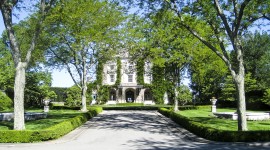Landscape Information
Created between 1908 and 1910 by architect William Welles Bosworth, the Japanese garden spans a terraced hillside immediately below the mansion. Bosworth’s design incorporated an oval pond edged by massive boulders, which is fed by a brook spanned by two wooden bridges (replaced in 1922 with granite replicas). A mahogany Meiji-style teahouse, built by Japanese architect T. Uyeda, was perched on the edge of the pond and nestled in a grove of blue spruces. It was surrounded by stroll gardens created by the Japanese gardener, Takahashi.
By the early 1960s the Japanese garden had become overgrown, and Nelson Rockefeller commissioned landscape architect David Harris Engel to expand and renovate it. The teahouse was relocated and set on a pine-shaded terrace above the brook. A new teahouse, designed in the shoin-style by Junzo Yoshimura, was built atop the original site in 1962. Stone-edged paths are lined with Asian stone ornaments and lanterns, and a step-stone path with a granite-slab bridge crosses the stream to a deep gorge and waterfall. The pond was expanded and edged with Japanese maples and yew. North of the teahouse, Engel created a dry garden of raked sand and a bamboo grove. The whole garden is planted with cherry trees, pruned azalea and rhododendron hedges, daffodils and day lilies, and carpeted banks of moss.
In 2007 the Kykuit property was given to the National Trust for Historic Preservation, the management relinquished to the Rockefeller Brothers Fund. The Kykuit Japanese Garden is open for public tours by appointment. It was designated a National Historic Landmark in 1976.











